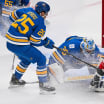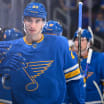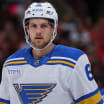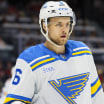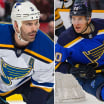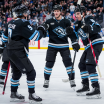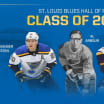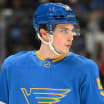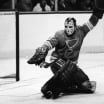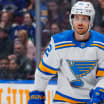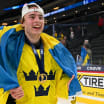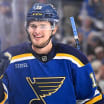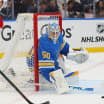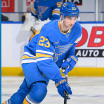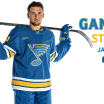Robby Fabbri knew it right away.
Well, maybe he didn't know at the exact moment his left leg twisted like no leg ever should, but five minutes later, he found himself sitting on a table in the medical room at Scottrade Center staring into the concerned faces of the team doctors who were looking at his knee.
That's when he knew his season was over.
The Long Road Back
Robby Fabbri's season-ending injury and the road to recovery
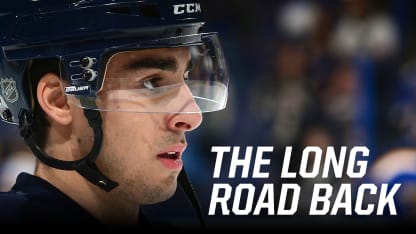
By
Chris Pinkert
St. Louis Blues
Done.
Past tense.
See ya next year.
The team doctors initially tried to hide their concern. They said things like "let's just go to the hospital and get an MRI done and see what the results say" or "let's not jump to any conclusions just yet."
But their faces didn't give him much hope or optimism.
"Give it to me straight," Fabbri demanded rather stubbornly. "Don't beat around the bush. What's the difference if I find out now or in a couple hours after an MRI?"
OK then. No beating around the bush.
This was the moment the truth came - and sometimes the truth hurts worse than any twisted leg or awkward fall into the boards.
"It's probably your ACL," one of the doctors said. "And it doesn't look good."
THE INJURY
"That's probably it for the year," another doctor said.
Fabbri stood up, winced because of the pain in his leg, and limped to his locker room stall to retrieve his phone. Back home in Mississauga, Len and Stef Fabbri would have been watching the game on TV when the injury happened, and they would be worried. Hearing John Kelly say "hopefully that is not as bad as it looks" during the TV broadcast is far from comforting for parents who just watched their son get helped off the ice.
"Headed to the hospital for an MRI," Fabbri told his parents over a text message.
On the ride to the Washington University Department of Orthopedics - while listening to the rest of the game on the radio - Fabbri began to replay the injury in his mind.
There he was, in his own zone along the wall ready to take a pass from Kevin Shattenkirk. The pass came, and Fabbri carried the puck across the blue line and into the neutral zone. Carter Rowney of the Pittsburgh Penguins made a bee-line towards him, trying to knock him off the puck before he could get it up to Nail Yakupov, who was speeding along the wall in prime position to create a scoring chance.
Fabbri did get the puck to Yakupov, but a fraction of a second later, Rowney delivered the hit.
Fabbri's right leg was in the air at the time and his left leg was dug firmly into the ice, so Rowney caught him at an awkward, off-balance moment that twisted his left leg around while it was trying to support all of his body weight.
Not good.
POP!
A sharp shooting pain came like a freight train at first, bringing an intense, exploding pressure. Then there was the tingling - it went from his knee all the way down to his foot.
"I had never felt that before. I wasn't sure what the injury would be," Fabbri said. "But I knew it was serious. It was a really sharp pain - and while I wouldn't say numb, I felt that tingling feeling all the way down, like my leg had fallen asleep."
Ray Barile, the Blues' head athletic trainer for nearly 23 years, leaped over the boards in an instant. He could hear Fabbri screaming, and even though play hadn't been blown dead yet, Barile had already sprung into action.
This was no day-to-day injury.
"Initially my thought was he had fractured his ankle," Barile said. "The way he went into the boards, I thought it was a broken bone. When I got out onto the ice and he told me it was his knee, I got a knot in my stomach."
Fabbri didn't feel the same dread. At least not yet.
He knew he was going to be out for awhile, but he wasn't thinking long-term. As he leans on the shoulders of others for help in getting to the locker room, he is already planning his return.
I've had injuries before and I've come back. Today is only Feb. 4. That leaves more than two months until the playoffs start. I'll definitely be back by then.
The MRI told a different story. It confirmed what the team doctors had already assumed: the anterior cruciate ligament in Fabbri's left knee, which 90 minutes ago was strong and completely healthy, had ripped apart. Not even a thread of ligament remained to hold it together.
That meant surgery.
And rehab.
It was going to be a long road back.
THE HARD PART
After the MRI, Fabbri returned home to the apartment he shares with teammate Joel Edmundson. The game was over - the Penguins dealt the Blues a 4-1 loss that stung in Mike Yeo's second game as the new head coach, but it didn't sting as much as losing Fabbri for the season did.
Edmundson still wasn't home from the game, so Fabbri makes himself an ice pack and hobbles to the black leather couch in their living room, where he ices the injury to help prevent any further swelling. Since he doesn't have much mobility, he sits there for awhile, responding to the text messages he got from concerned friends, family and teammates. He calls home to tell his mom and dad what happened and what the doctors had said, and talking about it keeps the realization that his season is done from sinking in too deep.
That realization comes the next day, when the team boards a flight to Philadelphia to begin an eight-day, four-game road trip that also takes them to Ottawa, Toronto and Montreal.
For the first time in his professional career - which at this point had reached 123 regular-season games - Fabbri was alone. Hockey players - or any athletes for that matter - share a unique bond, one that often develops into the strongest of friendships from battling together every game to reach a common goal.
When everyone else is gone, that's when the weight of a long-term injury becomes almost unbearable.
There was no time to pout, though.
Surgery was a month away, and there was a lot of work to be done before that.
Fabbri was back in the gym before the team returned home from their road trip.

"That was a pretty tough time, knowing I wasn't going to play for awhile and that I still had to work through the pain right way," Fabbri said. "The whole idea was to get the knee as strong as possible before I could go in for surgery. The better I was before surgery, the easier it would be after."
The ACL is the ligament that sits in the middle of the knee, attaching the thigh bone (femur) to the shinbone (tibia). It's what makes it possible for athletes to make sharp turns, speed up or slow down. It also allows for sudden stops or changes in direction, but these instances are when injuries frequently occur.
ACL injuries aren't as common in hockey as they are in football and basketball, mainly because skates don't lock into the ice the same way cleats do on turf or sneakers do on basketball courts. When a sudden change in direction occurs on skates, the player usually slips and falls, naturally protecting knee ligaments in the process.
"When an ACL is torn, you want to control the amount of swelling that happens in the knee," Barile said. "You want to regain the range of motion as quickly as you can, and you want to work on establishing the strength of the knee before the operation. Robby's knee reacted very favorably and didn't swell too much, so we were able to establish that pre-operative strength very quickly. Robby worked really hard, even though the injury was devastating to him. Once we explained the road ahead, he pushed all his chips into the middle of the table and went at it hard as a good pro would."
The surgery was performed in Chicago. Doctors took part of the patellar tendon from Fabbri's injured knee and placed it where the ACL should be, attaching it with screws in his femur and his tibia. According to Barile, with enough time, the body will transform the tendon into a fully-functioning ligament, making his surgically-repaired ACL practically as good as new.
Fabbri left the hospital with a brace that extended the length of his entire leg, keeping the knee locked straight. He needed crutches to get around, and he was told to stay off his feet as much as possible for awhile.
His mom - who works as a teacher and was off for spring break - visited him to help out, just to be around if he was too sore to do something on his own. When it was time for her to go back to work, his dad took a few days off from his accounting job to help, too.
"I think I was pretty stubborn," Fabbri recalled. "I wanted to do everything on my own. I felt like it was good mentally for me to get up and do things on my own and not just sit there like a couch potato and make other people do it for me. My parents, and 'Eddie,' got off the hook easy."
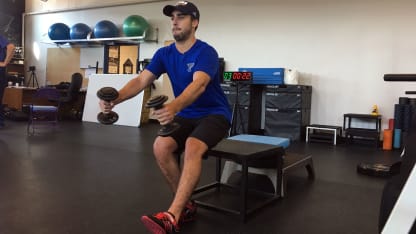
Back in St. Louis, therapy started immediately in the form of lying on the medical table for various leg raises and stretches, and subtle movements to help regain motion in the knee.
"Re-establishing range of motion can be a very difficult part for an athlete to do because it's painful and it's grueling," Barile said. "Once we have that established, we can develop a workout program for him that consists of a lot of single-leg activities, re-establishing strength in his quadriceps muscles, his hamstrings and continuing to work on the calf muscles to strengthen them. The whole time, we're always working on range of motion to make it equal to his uninjured knee."
"It would have been easy to get down and just sit there and do nothing and pout about it," Fabbri said. "But my goal throughout the whole thing was not to pout about it, to walk around with a smile on my face and keep moving forward."
THE COMEBACK
It's August.
Fabbri's leg brace and crutches are buried somewhere at his apartment, where they are currently collecting dust.
If you didn't know he had major surgery five months ago, you wouldn't be able to figure it out now by looking at him.
He's also been cleared to skate. Two days per week, he puts on full gear and gets moving on the ice like the injury never happened.
Recently, he's been skating again with some of his teammates, shooting pucks with his familiar CCM stick in his hands. Edmundson, Zach Sanford, Jordan Schmaltz and even newcomer Brayden Schenn have been on the ice with him, too, but they're not allowed to make contact with Fabbri yet.
That day will come.
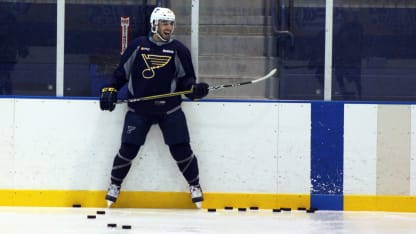
"Every morning, I'm working out in the gym," Fabbri said. "That involves a workout with (Strength and Conditioning Coach Eric Renaghan) and doing the rehab things necessary for that day for my body and for what I'm feeling. Right now I'm skating twice a week, and that's just getting started. I keep upping the skates every time I go on and listening to my knee with everything to see how far I can push it."
"Robby really knuckled down. He had experience with injuries before and that's been helpful," Barile said. "He is a battler and a grinder in the rehab process. He went after it every day and worked hard, and he understood that if we had setbacks or went too far, we'd have to scale it down a little bit and he was fine with that. But he worked hard every single day on his rehabilitation."
Speaking of setbacks - if there aren't any, Fabbri will be a full participant when training camp begins in September.
If this injury has taught him anything about himself, it's that he absolutely hates being a spectator. Being home alone while your friends are competing - either at Scottrade Center or on the road - is hard. But watching your teammates lose in six games to the Nashville Predators in the Western Conference semifinals - knowing that you might have been able to make a difference if you weren't in the wrong place at the wrong time way back in February - was almost as agonizing as the torn ACL and the rehab itself.
No, Fabbri doesn't want to be a spectator any more.
When the anthem begins on Opening Night in Pittsburgh, he wants to be staring up at 'Old Glory' from the blue line with his pads on, the Blue Note on his chest and a hockey stick in his hands.
"I've thought about it a few times. It's going to feel like playing my first NHL game again it's been so long," Fabbri said. "That first game in Pittsburgh, it's been running through my head a lot, getting back on the ice.
"I have a good two months here to really start pushing on the ice now that I'm cleared," he said. "I'm already seeing the improvements from the few skates that I've had. It's refreshing and it's exciting to get back on the ice and get back to what I love to do.
"I'm confident in myself that I'm going to be ready."

